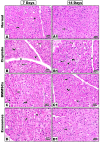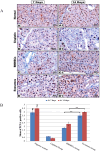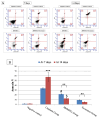Exosomes derived from bone marrow mesenchymal stem cells ameliorate chemotherapeutically induced damage in rats' parotid salivary gland
- PMID: 39821446
- PMCID: PMC11742274
- DOI: 10.1007/s10006-025-01331-9
Exosomes derived from bone marrow mesenchymal stem cells ameliorate chemotherapeutically induced damage in rats' parotid salivary gland
Abstract
Objective: A nanometer-sized vesicles originating from bone marrow mesenchymal stem cells (BMMSCs), called exosomes, have been extensively recognized. This study defines the impact of BMMSCs and their derived exosomes on proliferation, apoptosis and oxidative stress (OS) levels of CP-induced parotid salivary gland damage.
Methods: BMMSCs were isolated from the tibia of four white albino rats and further characterized by flowcytometric analysis. BMMSCs-derived exosomes were harvested and underwent characterization using transmission electron microscopy (TEM), western blot analysis and BCA assay. Fifty-six healthy white albino male rats weighting from 200 to 250 g were allocated into 4 groups (n = 14); Group I, rats received phosphate buffered saline (PBS), group II, rats were intraperitoneally injected with CP, group III& IV received CP and after 3 days they were intravenously injected with either BMMSCs (group III) or BMMSCs-exosomes (group IV). Histological, and immunohistochemical studies using proliferating cell nuclear antigen (PCNA) were done after 7 and 14 days. The OS was measured using malondialdehyde (MDA) and apoptosis was measured by annexin V-FITC/PI.
Results: BMMSCs and exosomes treated groups showed better histological features approximating the normal architecture of the control group. The percentage of PCNA positively stained cells were significantly higher in the exosomes treated group in comparison to all other groups. MDA assay test revealed that the exosomes were able to reduce the OS when compared to the cell-based therapy using BMMSCs. Annexin V revealed that BMMSCs-exosomes significantly reduced the percentage of apoptotic cells compared to other treated groups.
Conclusions: BMMSCs-exosomes could improve the CP-induced cytotoxicity in rats' parotid salivary gland.
Keywords: Bone marrow; Chemotherapy; Exosomes; Malondialdehyde; Parotid gland; Stem cells.
© 2025. The Author(s).
Conflict of interest statement
Declarations. Ethics approval and consent to participate: Experimental protocols of the current study were carried out in adherence to the appropriate criteria and were approved by the ethical committee of the Faculty of Dentistry at Mansoura University. Competing interests: The authors declare no competing interests.
Figures






References
MeSH terms
LinkOut - more resources
Full Text Sources
Research Materials
Miscellaneous

